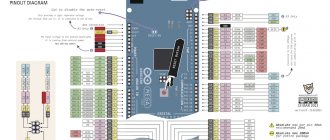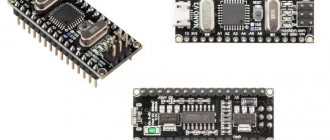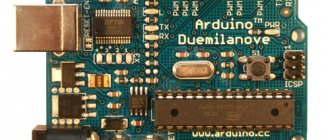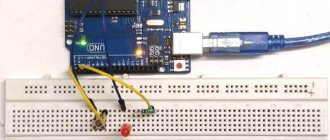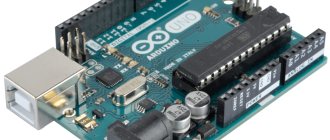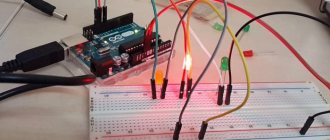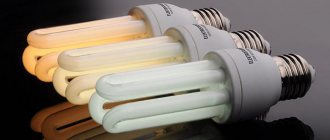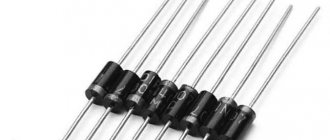Characteristics of Arduino Mega 2560
| Microcontroller | ATmega2560 |
| Operating voltage | 5V |
| Supply voltage (recommended) | 7-12V |
| Supply voltage (limit) | 6-20V |
| Digital inputs/outputs | 54 (14 of which can also function as PWM outputs) |
| Analog inputs | 16 |
| PWM (PWM) pins | 14 |
| DC current via input/output | 40 mA |
| Maximum pin output current 3.3V | 50 mA |
| Flash memory | 256 KB (of which 8 KB is used for the bootloader) |
| SRAM/RAM | 8 KB |
| EEPROM | 4 KB |
| Clock frequency | 16 MHz |
| Built-in LED | 13 |
| Length | 101.6 mm |
| Width | 53.4 mm |
| Weight | 25 g |
Schematic diagram
Arduino Mega 2560 CH340G
This board has all the properties of the classic Arduino Mega 2560 Rev3 board. The main differences from the original are due to the fact that to reduce the cost of the board, a USB bridge is used, made on a budget CH340G chip. All elements of external connections, including port names, on this board fully correspond to the circuit diagram of the original board.
For the CH340G USB bridge chip, you need to install drivers on your computer, which can be downloaded here.
Schematic diagram
Description of Arduino Mega 2560 board elements
- Microcontroller ATmega2560 - The heart of the Arduino Mega 2560 platform is the 8-bit microcontroller of the AVR family - ATmega2560. It provides 256 KB of flash memory for firmware storage, 8 KB of SRAM and 4 KB of non-volatile EEPROM memory for data storage.
- ATmega16U2 microcontroller - The ATmega16U2 microcontroller provides communication between the ATmega2560 microcontroller and the computer's USB port. When connected to a PC, the Arduino Mega 2560 is defined as a virtual COM port. The firmware of the 16U2 chip uses standard USB-COM drivers - no installation of external drivers is required.
- I/O Ports
- LED indication RX and TX - Blink when data is exchanged between the Arduino Mega 2560 and the PC.
- L — Output LED 13. When set to HIGH, the LED turns on, when set to LOW, it turns off.
- ON - Power supply available on Arduino Mega 2560.
History of creation
I have a cold veranda in my house, which has never had heating, and, in principle, was not planned. And one day the question arose about installing a farm (miner) for mining cryptocurrency. It was decided to use this particular room, since the equipment was quite noisy, and it was not possible to place it in the residential part of the house. In addition, the miner generates a huge amount of heat. It turns out two birds with one stone - both bitcoins are mined and the veranda is heated due to the heat generated by the farm

